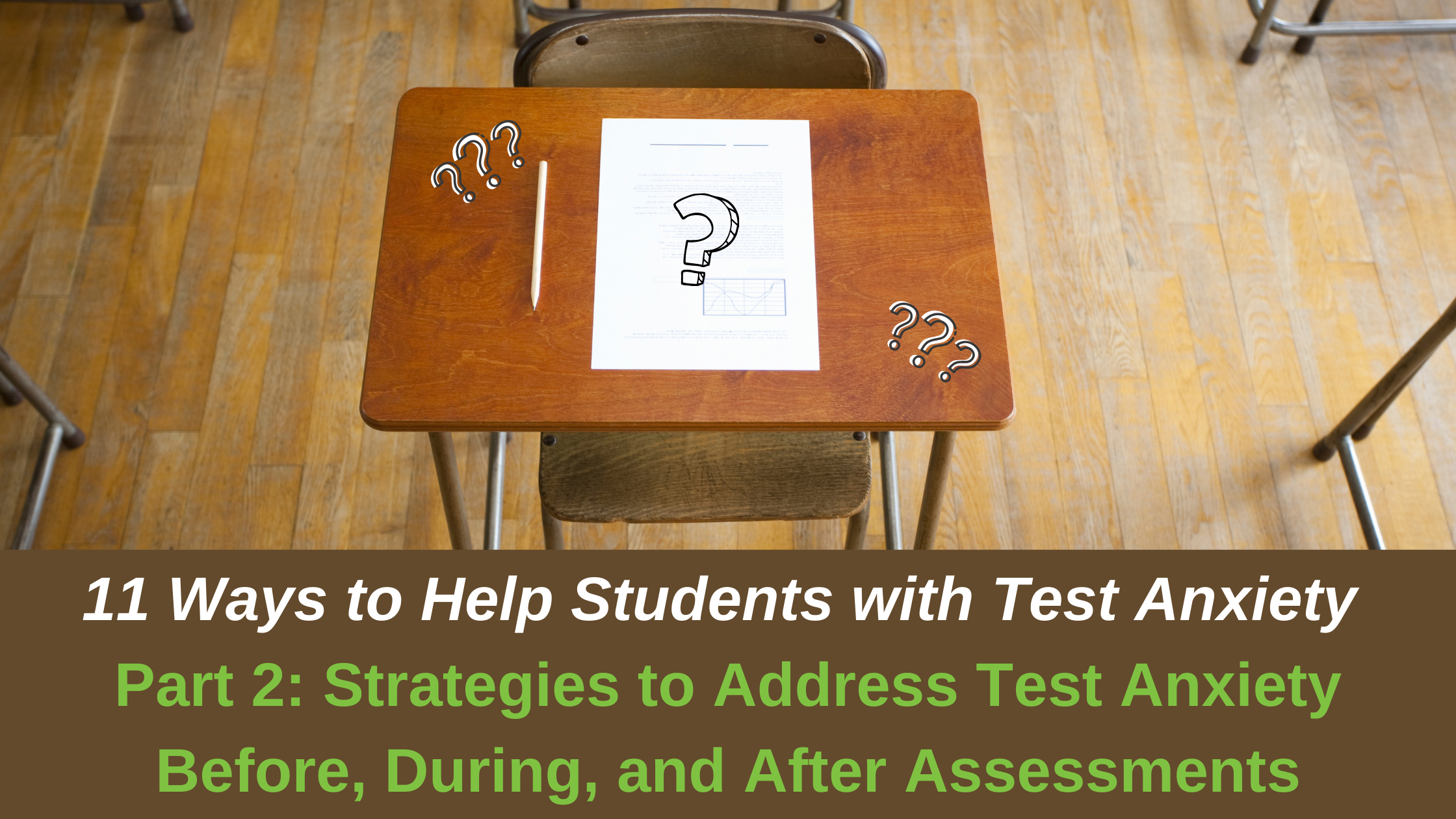
In Part 1, we defined Test Anxiety and common signals that students are anxious about an assessment. We also discussed some general best practices for putting some of these anxieties in perspective and creating a healthy learning environment to ease the concerns, helping students normalize testing as a part of their learning process. By mitigating the often-looming imagination of worst-case scenario outcomes, we help students embrace testing as a key piece of informing the next steps in their own growth. In Part 2, we will dive deeper into strategies for educators to address test anxiety before, during and after the assessment.
Strategies for Before the Assessment:
1. Be pragmatic.
In my experience, it often helps students when we take the mystery out of certain aspects of the assessment. If the assessment is not in your classroom, show the student where it will take place and where they will sit. Talk about who will proctor the test, the time they will have available, and what materials they can bring. Answer any questions they may have and explicitly teach rules and expectations for the assessment. Once, a student of mine was very anxious about taking the PSAT; it turned out she was under the impression that she would not be allowed to use the bathroom during the entire test. Show them where the nearest bathroom is located. I have had teachers say to me before that all of these things take too much time during the school day. However, a few minutes spent working on these practical matters can greatly increase positive student behavior on testing days.
2. Help students focus on what they can control.
I always tell my students that while they may not be able to have power over everything about an assessment, there are actually a number of things that are within their control. An easy way to explain this is to create a visual concept map or web with your students (like this), with ideas of things they can control that will help them on test day. Examples: eating a good breakfast, getting enough sleep the night before, studying in advance, organizing notes and materials, etc. This practice reinforces the idea that they are not helpless when faced with a test, but can instead help themselves in many ways.
It is also important to incorporate study skills into special education classes, as many students may struggle with the process of studying for an assessment. Here are a few useful resources for teaching study skills:
-
-
- A nice list with information on teaching study skills for elementary students , as it is important to start working on these in the elementary grades.
- I love this four-step plan for gradually releasing responsibility with student study skills.
- While this resource has a price tag, I think it’s a great study skills workbook.
- I always love a choice board—here is a free menu with study skills options.
-
3. Encourage caregivers to keep worry to themselves.
Sometimes caregivers can add to student assessment stress by sharing their negative past academic experiences or current anxiety about their student’s progress. I would see this happen often in math classes, where many parents had their own complex feelings about math and would sometimes project these thoughts onto their children. Here is a resource to share with caregivers to help make them part of the team boosting student morale instead of hindering it.
4. Leave an encouraging note and/or schedule reminder.
For classroom assessments, I would often leave an encouraging note on the whiteboard for students to see before the test. Sometimes I would leave a sticky note on student desks with more individualized encouragement. This is a prime example of where your personal relationships will be a great asset, knowing what works for your specific students. For example, one note may be: “I know you had a rough morning, but I am so excited to see what you know on this history test! You can do it! Then you get to relax in the comfy corner when you are done.” Another student may get a very different note, such as, “Wow—you scored an 85% on your last history unit test, can you beat your last score???” Another student may receive a “first, then” visual with a picture of a test and then a preferred activity as a gentle schedule and reinforcement reminder.
5. Try an anxiety worksheet or journal activity.
I often used “worry worksheets” or journaling activities for students with persistent testing anxiety. Many liked to fill in a “worry jar” visual with all their worries about the test or what would happen because of the test. Other students liked rating scale-type worksheets where they could rate their anxiety and compare it to other life events to see that it was not as big of a worry as they thought. Some other students liked to work on changing negative thoughts into positive ones. Other students liked to journal about their concerns. My advice is to work with your school social worker or psychologist for help obtaining these kinds of resources.
Strategies for During the Assessment:
6. Teach basic test-taking strategies.
One of the worst things to see during an assessment is when a student will panic, freeze, and then not do the test. To combat this I like to teach basic test-taking strategies throughout the school year and keep them posted in the classroom so that students always have an idea of where to start.
Some strategies I like to teach are below:
-
-
- Start by answering the questions you know first.
- Circle questions you do not know and come back to them at the end.
- Write formulas or anything you think you will forget at the top of your test right away.
- Read all instructions and directions before starting.
- Use a highlighter or underline key words.
- Search for “trick” words in questions, such as “always” or “never.”
- Cross off multiple choice answers that you know are incorrect.
- Try a mantra or positive affirmation.
-
Prior to testing it can help to work with students on creating a mantra, or short phrase, that they can repeat in their head during assessments to help stay focused and confident. For example, something like, “I am prepared for this test,” or “I have finished tests before.” It is important that you do not give the student the mantra, but it is a phrase that really resonates with them and instills confidence. I have also found it helpful to focus on completion and getting through the test instead of on the result or score. These mandala mantra coping skills cards are not only cute but useful!
8. Teach breathing exercises and grounding strategies.
Some students may require help learning different breathing relaxation techniques, such as square breathing, that they can do during an assessment to help stay calm. Here is a helpful resource with simple breath exercises for kids. Grounding strategies refer to tools we can use to help students take their mind away from anxious thoughts and come back to the present moment, in this case, their assessment. Here is a list of ten grounding strategies to work on with students. These strategies may work for certain students, while others may need a different approach like the one below.
9. Reframe anxiety as adrenaline.
For some of my students, it has been helpful to work on reframing anxiety in a positive light. For example, we can choose to experience the feelings anxiety brings more like adrenaline pumping us up to do difficult tasks. There is an excellent TedTalk about this here. This has worked for some of my students who liked sports and liked to try to beat their scores on previous assessments.
Strategies for After the Assessment:
10. Maintain student confidentiality.
Remember, keeping student grades and scores confidential is not only good practice but also the law, under the Family Educational Rights and Privacy Act (FERPA). Please do not put grades or scores up on a bulletin board, discuss with staff that are not part of the student’s IEP team, or talk loudly about scores in the classroom. When students turn eighteen parents may not have immediate access to grades and scores without a signed form. I have personally had to work on training paraprofessionals quite a bit in this area, especially if they help you with grading in the classroom. Maintaining confidentiality is a clear step in gaining student trust and decreasing anxiety.
11. Celebrate!
Hopefully you were able to help your students with assessment anxiety get through an assessment with less stress! That is something to be celebrated. Have students complete a de-escalation activity, such as journaling, relaxing, coloring, using sensory items, etc. before going on to the next activity. If you are giving out rewards, such as preferred activities or even items like stickers, make sure they are for finishing the task, not based on scores. One of the worst mishandling of rewards I have seen was when students completed their district-wide progress monitoring assessments and staff decided to give out fun necklaces only to the students who had improved scores. So many factors go in to student assessment performance that this is really not an equitable practice, and many of my students in special education were mortified to not earn a necklace to wear around school the rest of the day, which lead to more anxiety around testing. We want to add positive memories to assessment experiences, so that we can reference these with students in the future.
Let us know if you try any of these strategies in your own classroom or if you have your own to share! Leave a comment with your insights and learnings below.





